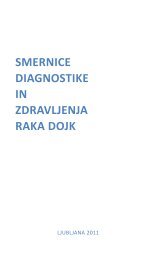You also want an ePaper? Increase the reach of your titles
YUMPU automatically turns print PDFs into web optimized ePapers that Google loves.
Electrogene therapy with p53 alone and in combination<br />
with electrochemotherapy using cisplatin in treatment<br />
of murine sarcomas<br />
Alenka Gro{el, Maja ^ema`ar, Simona Kranjc, Suzana Mesojednik,<br />
Gregor Tev`, Gregor Ser{a<br />
Dept. of Experimental Oncology, Institute of Oncology, Zalo{ka 2,<br />
SI-1000 Ljubljana, Slovenia<br />
Electroporation is an established method for the delivery of molecules into<br />
the cells. Biomedical application of electroporation in vivo is either delivery of<br />
chemotherapeutic drugs - electrochemotherapy or DNA - electrically assisted gene<br />
delivery or electrogene therapy. p53 plays crucial role in diverse cellular pathways<br />
in response to DNA damage, one of them being apoptotic cell death. Cisplatin, a<br />
commonly used chemotherapeutic agent, causes tumor cell death by producing<br />
DNA damage and generating reactive oxygen intermediates. Our hypothesis was<br />
that increased DNA damage due to increased cellular concentration of cisplatin by<br />
electroporation e.g. electrochemotherapy would result in at least additive antitumor<br />
effect in p53 electrogene therapy pre-treated tumors.<br />
Aim of our study was to evaluate feasibility and therapeutic potential of electrogene<br />
therapy with p53 alone or combined with electrochemotherapy using cisplatin in<br />
two murine sarcomas with different p53 status.<br />
In order to demonstrate feasibility and therapeutic potential murine subcutaneous<br />
sarcomas (LPB and SA-1) were treated either with plasmid DNA, cisplatin or<br />
electroporation and combinations of these treatments. Status of p53 in the tumors was<br />
determined immunohistochemically, transfection efficacy by luciferase expression in<br />
the tumors and antitumor effectiveness of the treatments by tumor growth delay and<br />
determination of tumor free animals.<br />
Antitumor effectiveness of three consecutive electrogene treatments with p53 was<br />
dependent on the status of p53 being more effective in wild type LPB tumor than<br />
in mutated SA-1 tumor. Pretreatment of tumors with electrogene therapy with p53<br />
enhanced chemosensitivity of both tumor models treated by electrochemotherapy<br />
with cisplatin. After only one treatment in LPB tumor model, tumor growth delay<br />
was prolonged for 10 days in combined treatment group compared to electrogene<br />
therapy with p53 or electrochemotherapy with cisplatin alone, whereas in SA-1<br />
tumors this treatment combination resulted in 32% of cured animals.<br />
In conclusion, results of our study show that electrogene therapy with p53 alone<br />
or combined with electrochemotherapy is feasible and effective in treatment of<br />
tumors. The combination of electrogene therapy and electrochemotherapy after<br />
only one treatment resulted beside prolonged tumor growth delay also in tumor<br />
free animals.<br />
p1283

















